Future Landslide Characteristic Assessment Using Ensemble Climate Change Scenarios: A Case Study in Taiwan
Abstract
1. Introduction
2. Climate Change Scenarios
2.1. Base Period (1979–2003)
2.2. End of 21st Century (2075–2099)
3. Data and Methods
3.1. Climate Change Data in Taiwan
3.2. Calculation of Landslide-Area Characteristics
4. Results
5. Discussion
6. Conclusions
Author Contributions
Funding
Acknowledgments
Conflicts of Interest
References
- IPCC. Climate Change 2007: The Physical Science Basis; Summary for Policymakers; Contribution of Working Group I to the Fourth Assessment Report; The Intergovernmental Panel on Climate Change: Geneva, Switzerland, 2007. [Google Scholar]
- IPCC. Climate Change 2013: The Physical Science Basis; Summary for Policymakers; Contribution of Working Group I to the Fifth Assessment Report; The Intergovernmental Panel on Climate Change: Geneva, Switzerland, 2013. [Google Scholar]
- Crozier, M.J. Deciphering the effect of climate change on landslide activity: A review. Geomorphology 2010, 124, 260–267. [Google Scholar] [CrossRef]
- Kao, S.C.; Ganguly, A.R. Intensity, duration, and frequency of precipitation extremes under 21st-century warming scenarios. J. Geophys. Res.-Atmos. 2011, 116. [Google Scholar] [CrossRef]
- Jibson, R.W.; Keefer, D.K. Statistical analysis of factors affecting landslide distribution in the New Madrid seismic zone, Tennessee and Kentucky. Eng. Geol. 1989, 27, 509–542. [Google Scholar] [CrossRef]
- Nagarajan, R.; Roy, A.; Kumar, R.V.; Mukherjee, A.; Khire, M.V. Landslide hazard susceptibility mapping based on terrain and climatic factors for tropical monsoon regions. B Eng. Geol. Environ. 2000, 58, 275–287. [Google Scholar] [CrossRef]
- Collison, A.; Wade, S.; Griffiths, J.; Dehn, M. Modelling the impact of predicted climate change on landslide frequency and magnitude in SE England. Eng. Geol. 2000, 55, 205–218. [Google Scholar] [CrossRef]
- Soldati, M.; Corsini, A.; Pasuto, A. Landslides and climate change in the Italian Dolomites since the Late glacial. Catena 2004, 55, 141–161. [Google Scholar] [CrossRef]
- Jakob, M.; Lambert, S. Climate change effects on landslides along the southwest coast of British Columbia. Geomorphology 2009, 107, 275–284. [Google Scholar] [CrossRef]
- Melchiorre, C.; Frattini, P. Modelling probability of rainfall-induced shallow landslides in a changing climate, Otta, Central Norway. Clim. Chang. 2012, 113, 413–436. [Google Scholar] [CrossRef]
- Turkington, T.; Remaître, A.; Ettema, J.; Hussin, H.; van Westen, C. Assessing debris flow activity in a changing climate. Clim. Chang. 2016, 137, 293–305. [Google Scholar] [CrossRef]
- Chiang, S.H.; Chang, K.T. The potential impact of climate change on typhoon-triggered landslides in Taiwan, 2010–2099. Geomorphology 2011, 133, 143–151. [Google Scholar] [CrossRef]
- Timbal, B.; Jones, D.A. Future projections of winter rainfall in southeast Australia using a statistical downscaling technique. Clim. Chang. 2008, 86, 165–187. [Google Scholar] [CrossRef]
- Timm, O.; Diaz, H.F. Synoptic-statistical approach to regional downscaling of IPCC twenty-first-century climate projections: Seasonal rainfall over the Hawaiian Islands. J. Clim. 2009, 22, 4261–4280. [Google Scholar] [CrossRef]
- Sunyer, M.A.; Madsen, H.; Ang, P.H. A comparison of different regional climate models and statistical downscaling methods for extreme rainfall estimation under climate change. Atmos. Res. 2012, 103, 119–128. [Google Scholar] [CrossRef]
- Chen, C.W.; Tung, Y.S.; Liou, J.J.; Li, H.C.; Cheng, C.T.; Chen, Y.M.; Oguchi, T. Assessing landslide characteristics in a changing climate in northern Taiwan. Catena 2019, 175, 263–277. [Google Scholar] [CrossRef]
- Chen, C.W.; Saito, H.; Oguchi, T. Rainfall intensity–duration conditions for mass movements in Taiwan. Prog. Earth Planet. Sci. 2015, 2, 1–13. [Google Scholar] [CrossRef]
- Wu, C.H.; Chen, S.C. Determining landslide susceptibility in Central Taiwan from rainfall and six site factors using the analytical hierarchy process method. Geomorphology 2009, 112, 190–204. [Google Scholar] [CrossRef]
- Wu, C.H.; Chen, S.C.; Chou, H.T. Geomorphologic characteristics of catastrophic landslides during typhoon Morakot in the Kaoping Watershed, Taiwan. Eng. Geol. 2011, 123, 13–21. [Google Scholar] [CrossRef]
- Emanuel, K. Increasing destructiveness of tropical cyclones over the past 30 years. Nature 2005, 436, 686–688. [Google Scholar] [CrossRef]
- Webster, P.J.; Holland, G.J.; Curry, J.A.; Chang, H.R. Changes in tropical cyclone number, duration, and intensity in a warming environment. Science 2005, 309, 1844–1846. [Google Scholar] [CrossRef]
- Tu, J.Y.; Chou, C.; Chu, P.S. The abrupt shift of typhoon activity in the vicinity of Taiwan and its association with western North Pacific–East Asian climate change. J. Clim. 2009, 22, 3617–3628. [Google Scholar] [CrossRef]
- Hsu, H.H.; Chou, C.; Wu, Y.C.; Lu, M.M.; Chen, C.T.; Chen, Y.M. Climate Change in Taiwan: Scientific Report 2011 (Summary); National Science Council: Taipei, Taiwan, 2011. [Google Scholar]
- Mizuta, R.; Arakawa, O.; Ose, T.; Kusunoki, S.; Endo, H.; Kitoh, A. Classification of CMIP5 future climate responses by the tropical sea surface temperature changes. SOLA 2014, 10, 167–171. [Google Scholar] [CrossRef]
- Wilks, D.S. Statistical Methods in the Atmospheric Sciences; Academic press: Oxford, UK, 2011; Volume 100, p. 704. [Google Scholar]
- Roble, R.G.; Ridley, E.C. A thermosphere-ionosphere-mesosphere-electrodynamics general circulation model (TIME-GCM): Equinox solar cycle minimum simulations (30–500 km). Geophys. Res. Lett. 1994, 21, 417–420. [Google Scholar] [CrossRef]
- Johns, T.C.; Carnell, R.E.; Crossley, J.F.; Gregory, J.M.; Mitchell, J.F.; Senior, C.A.; Tett, S.F.B.; Wood, R.A. The second Hadley Centre coupled ocean-atmosphere GCM: Model description, spinup and validation. Clim. Dyn. 1997, 13, 103–134. [Google Scholar] [CrossRef]
- Mizuta, R.; Yoshimura, H.; Murakami, H.; Matsueda, M.; Endo, H.; Ose, T.; Kamiguchi, K.; Hosaka, M.; Sugi, M.; Yukimoto, S.; et al. Climate simulations using MRI-AGCM3.2 with 20-km grid. J. Meteorol. Soc. Jpn. 2012, 90, 233–258. [Google Scholar] [CrossRef]
- Murakami, H.; Wang, Y.; Yoshimura, H.; Mizuta, R.; Sugi, M.; Shindo, E.; Adachi, Y.; Yukimoto, S.; Hosaka, M.; Kusunoki, S.; et al. Future changes in tropical cyclone activity projected by the new high-resolution MRI-AGCM. J. Clim. 2012, 25, 3237–3260. [Google Scholar] [CrossRef]
- Murakami, H.; Hsu, P.C.; Arakawa, O.; Li, T. Influence of model biases on projected future changes in tropical cyclone frequency of occurrence. J. Clim. 2014, 27, 2159–2181. [Google Scholar] [CrossRef]
- Giorgi, F.; Mearns, L.O. Calculation of average, uncertainty range, and reliability of regional climate changes from AOGCM simulations via the reliability ensemble averaging (REA) method. J. Clim. 2002, 15, 1141–1158. [Google Scholar] [CrossRef]
- Ruosteenoja, K.; Tuomenvirta, H.; Jylhä, K. GCM-based regional temperature and precipitation change estimates for Europe under four SRES scenarios applying a super-ensemble pattern-scaling method. Clim. Chang. 2007, 81, 193–208. [Google Scholar] [CrossRef]
- Kling, H.; Fuchs, M.; Paulin, M. Runoff conditions in the upper Danube basin under an ensemble of climate change scenarios. J. Hydrol. 2012, 424, 264–277. [Google Scholar] [CrossRef]
- Müller, W.A.; Appenzeller, C.; Doblas-Reyes, F.J.; Liniger, M.A. A debiased ranked probability skill score to evaluate probabilistic ensemble forecasts with small ensemble sizes. J. Clim. 2005, 18, 1513–1523. [Google Scholar] [CrossRef]
- Tiwari, M.K.; Chatterjee, C. Uncertainty assessment and ensemble flood forecasting using bootstrap based artificial neural networks (BANNs). J. Hydrol. 2010, 382, 20–33. [Google Scholar] [CrossRef]
- Wu, T.; Li, H.C.; Wei, S.P.; Chen, W.B.; Chen, Y.M.; Su, Y.F.; Liu, J.J.; Shih, H.J. A comprehensive disaster impact assessment of extreme rainfall events under climate change: A case study in Zheng-wen river basin, Taiwan. Environ. Earth Sci. 2016, 75, 597. [Google Scholar] [CrossRef]
- Chao, Y.C.; Chen, C.W.; Li, H.C.; Chen, Y.M. Riverbed Migrations in Western Taiwan under Climate Change. Water 2018, 10, 1631. [Google Scholar] [CrossRef]
- Fischer, E.M.; Knutti, R. Anthropogenic contribution to global occurrence of heavy-precipitation and high-temperature extremes. Nat. Clim. Chang. 2015, 5, 560–564. [Google Scholar] [CrossRef]
- Eyring, V.; Bony, S.; Meehl, G.A.; Senior, C.A.; Stevens, B.; Stouffer, R.J.; Taylor, K.E. Overview of the Coupled Model Intercomparison Project Phase 6 (CMIP6) experimental design and organization. Geosci. Model Dev. 2016, 9, 1937–1985. [Google Scholar] [CrossRef]
- Hungr, O.; McDougall, S. Two numerical models for landslide dynamic analysis. Comput. Geosci. 2009, 35, 978–992. [Google Scholar] [CrossRef]
- Katz, O.; Morgan, J.K.; Aharonov, E.; Dugan, B. Controls on the size and geometry of landslides: Insights from discrete element numerical simulations. Geomorphology 2014, 220, 104–113. [Google Scholar] [CrossRef]
- Van Westen, C.J.; Rengers, N.; Soeters, R. Use of geomorphological information in indirect landslide susceptibility assessment. Nat. Hazards 2003, 30, 399–419. [Google Scholar] [CrossRef]
- Bai, S.B.; Wang, J.; Lü, G.N.; Zhou, P.G.; Hou, S.S.; Xu, S.N. GIS-based logistic regression for landslide susceptibility mapping of the Zhongxian segment in the Three Gorges area, China. Geomorphology 2010, 115, 23–31. [Google Scholar] [CrossRef]
- Borgatti, L.; Soldati, M. Landslides as a geomorphological proxy for climate change: A record from the Dolomites (northern Italy). Geomorphology 2010, 120, 56–64. [Google Scholar] [CrossRef]
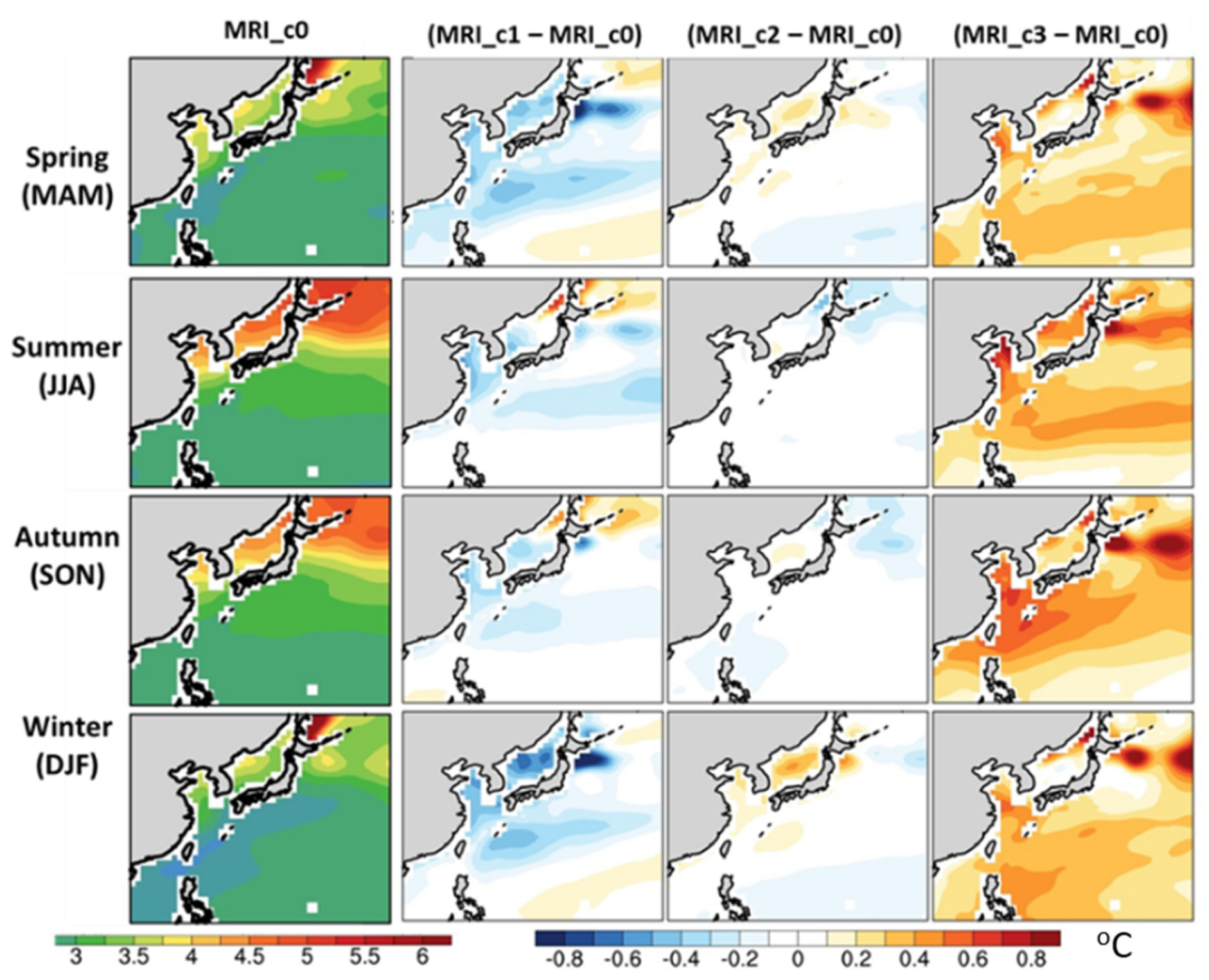
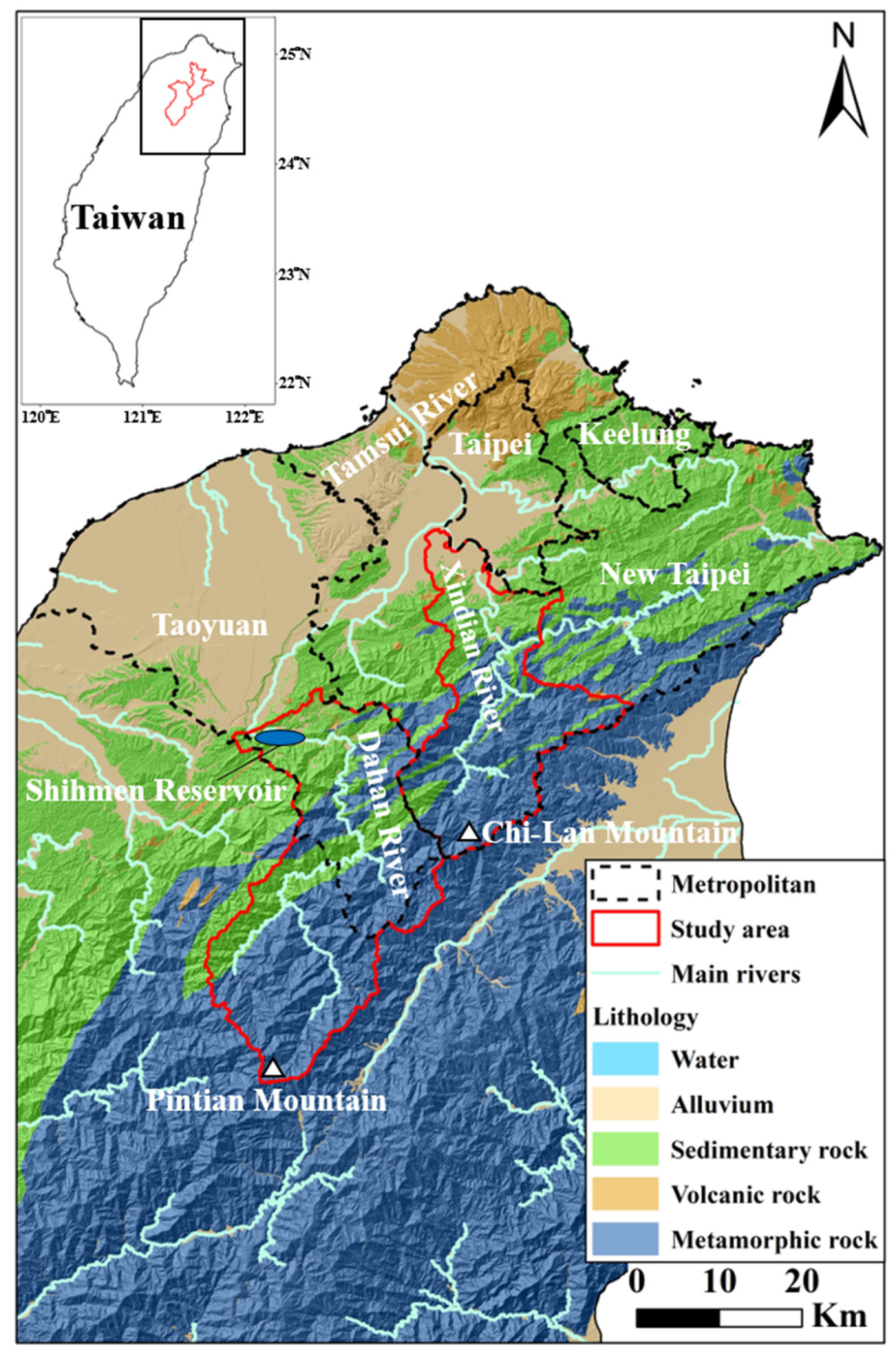
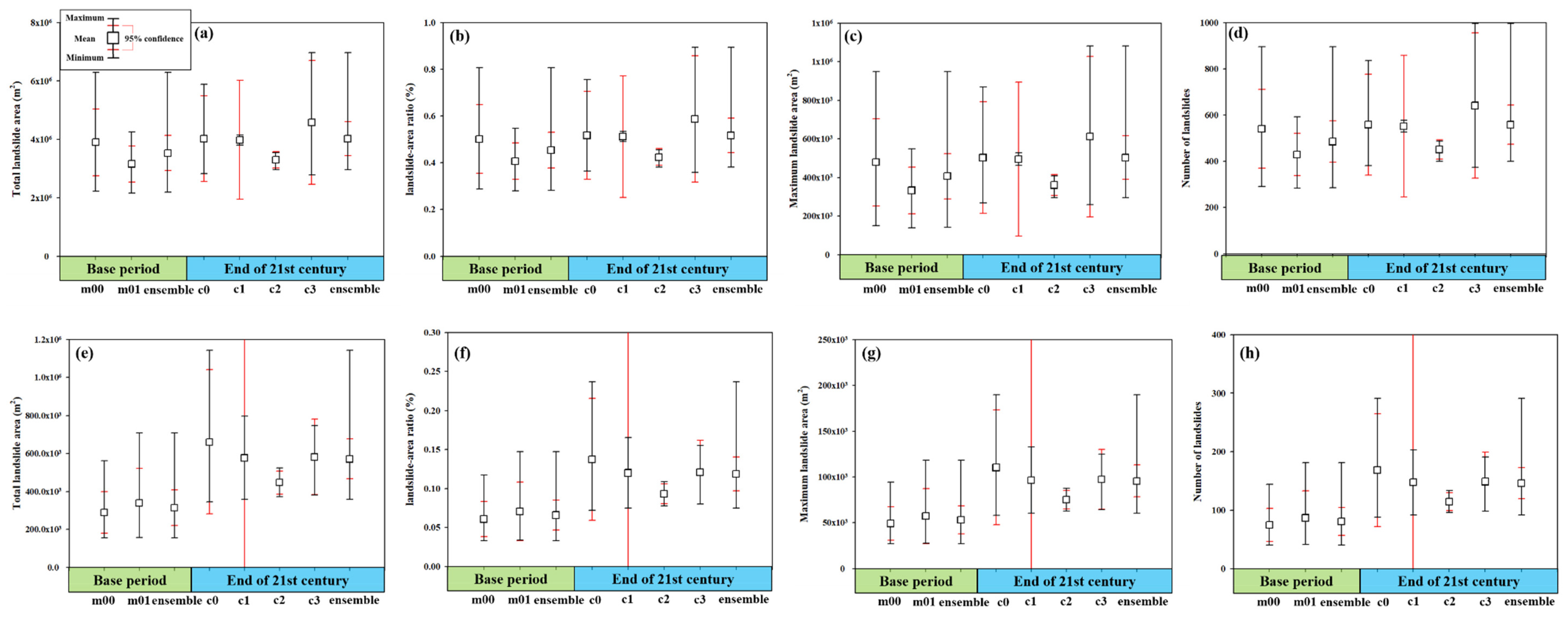
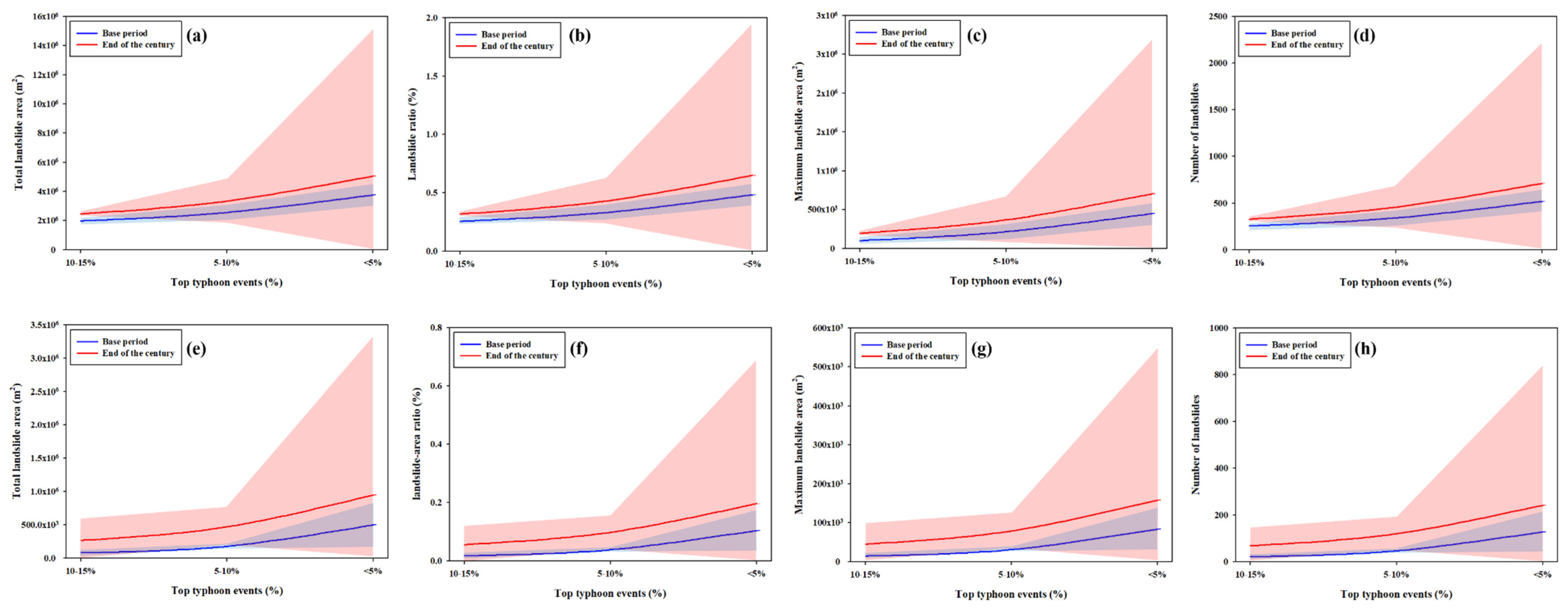
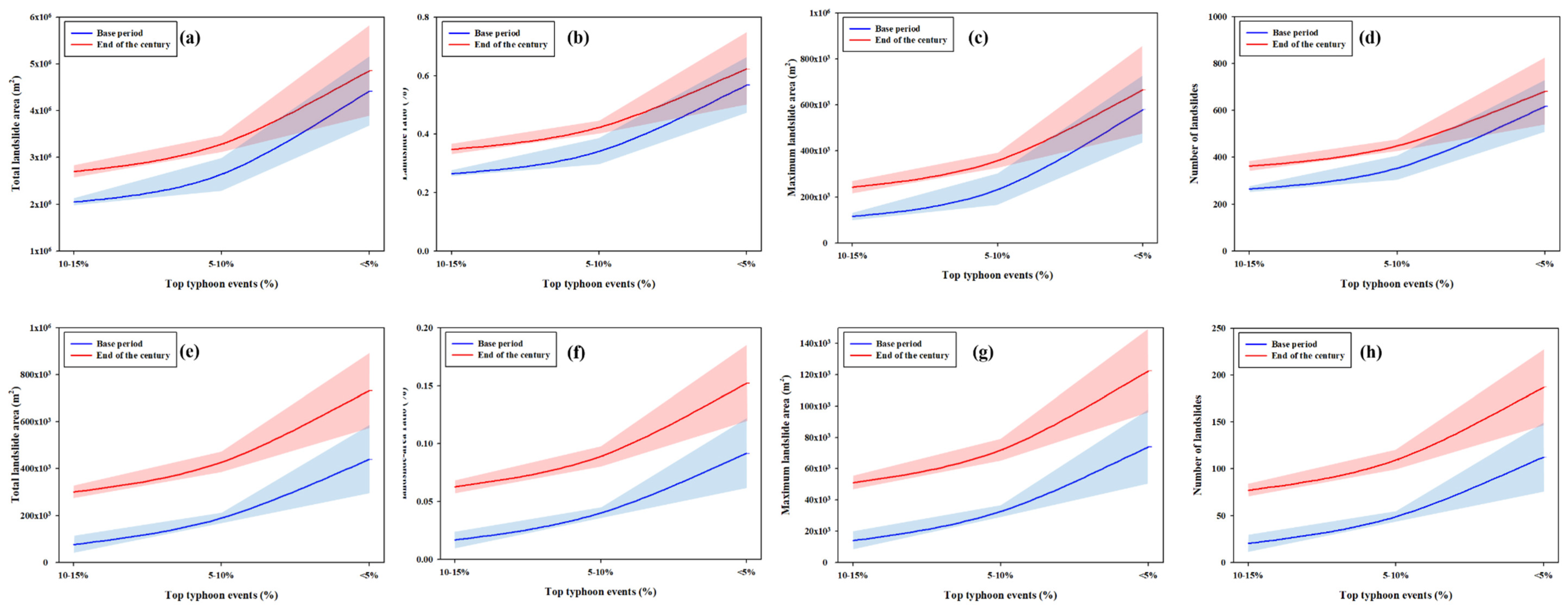
| Scenario | Total Number of Typhoons | Number of Top Typhoons | ||
|---|---|---|---|---|
| 5% | 10% | 15% | ||
| m00 | 82 | 4 | 8 | 12 |
| m01 | 84 | 4 | 8 | 12 |
| Ensemble | 166 | 8 | 16 | 24 |
| c0 | 45 | 2 | 5 | 7 |
| c1 | 23 | 1 | 2 | 3 |
| c2 | 55 | 3 | 6 | 9 |
| c3 | 46 | 2 | 5 | 7 |
| Ensemble | 169 | 8 | 17 | 25 |
| Scenario | Cumulative Rainfall (mm) | Peak Rainfall Intensity (mm/h) | Number of Landslides | Maximum Landslide Area (m2) | Total Landslide Area (km2) | Landslide-Area Ratio (%) | |
|---|---|---|---|---|---|---|---|
| Base period | m00 | 250.20–1183.69 (522.37) | 20.27–53.70 (35.19) | 245–896 (435) | 8.87 × 104–9.49 × 105 (3.40 × 105) | 1.91–6.30 (3.19) | 0.25–0.81 (0.41) |
| m01 | 222.30–749.31 (432.08) | 18.20–58.76 (36.30) | 226–593 (372) | 6.29 × 104–5.49 × 105 (2.56 × 105) | 1.78–4.26 (2.77) | 0.23–0.55 (0.36) | |
| End of 21st century | c0 | 365.92–1097.48 (605.22) | 32.76–72.01 (54.80) | 326–836 (493) | 1.95 × 105–8.70 × 105 (4.11 × 105) | 2.46–5.89 (3.58) | 0.32–0.76 (0.46) |
| c1 | 528.53–726.81 (636.71) | 24.85–61.51 (46.33) | 439–578 (514.67) | 3.45 × 105–5.28 × 105 (4.45 × 105) | 3.22–4.15 (3.73) | 0.41–0.53 (0.48) | |
| c2 | 374.73–597.31 (487.72) | 26.28–60.20 (45.23) | 332–487 (410.91) | 2.03 × 105–4.09 × 105 (3.08 × 105) | 2.50–3.54 (3.03) | 0.32–0.46 (0.39) | |
| c3 | 353.68–1327.07 (685.82) | 36.09–93.29 (54.74) | 318–996 (549) | 1.84 × 105–1.08 × 106 (4.90 × 105) | 2.40–6.97 (3.96) | 0.31–0.89 (0.51) | |
| Scenario | Cumulative Rainfall (mm) | Peak Rainfall Intensity (mm/h) | Number of Landslides | Maximum Landslide Area (m2) | Total Landslide Area (km2) | Landslide-Area Ratio (%) | |
|---|---|---|---|---|---|---|---|
| Base period | m00 | 122.42–700.96 (371.45) | 22.92–46.73 (32.19) | 0–144 (56) | 8.85 × 102–9.43 × 104 (3.72 × 104) | 0.06–0.56 (0.24) | 0.00–0.12 (0.05) |
| m01 | 146.29–553.02 (303.62) | 25.09–52.85 (33.68) | 13–181 (65) | 9.40 × 103–1.18 × 105 (4.31 × 104) | 0.05–0.71 (0.26) | 0.02–0.15 (0.05) | |
| End of 21st century | c0 | 211.56–685.89 (395.58) | 33.13–71.17 (46.11) | 62–291 (140) | 4.10 × 104–1.90 × 105 (9.09 × 104) | 0.24–1.14 (0.55) | 0.05–0.24 (0.12) |
| c1 | 298.61–670.32 (483.30) | 34.09–56.57 (41.55) | 68–203 (113) | 4.47 × 104–1.33 × 105 (7.40 × 104) | 0.26–0.80 (0.44) | 0.06–0.17 (0.09) | |
| c2 | 121.50–556.64 (318.87) | 31.54–45.04 (39.05) | 52–134 (98) | 3.47 × 104–8.77 × 104 (6.42 × 104) | 0.20–0.52 (0.38) | 0.04–0.11 (0.08) | |
| c3 | 73.46–1358.02 (508.37) | 36.01–54.53 (44.30) | 79–191 (129.29) | 5.23 × 104–1.25 × 105 (8.49 × 104) | 0.31–0.75 (0.51) | 0.06–0.16 (0.11) | |
| Top Typhoons | Shihmen Reservoir Catchment | Xindian River Catchment | ||||
|---|---|---|---|---|---|---|
| Base Period | End of 21st Century | Percentage Increase | Base Period | End of 21st Century | Percentage Increase | |
| 5% | 0.57 ± 0.09% | 0.62 ± 0.12% | 8% | 0.09 ± 0.03% | 0.16 ± 0.03% | 77% |
| 5–10% | 0.34 ± 0.04% | 0.42 ± 0.02% | 24% | 0.04 ± 0.01% | 0.09 ± 0.01% | 125% |
| 10–15% | 0.27 ± 0.01% | 0.35 ± 0.02% | 29% | 0.02 ± 0.01% | 0.06 ± 0.00% | 200% |
© 2020 by the authors. Licensee MDPI, Basel, Switzerland. This article is an open access article distributed under the terms and conditions of the Creative Commons Attribution (CC BY) license (http://creativecommons.org/licenses/by/4.0/).
Share and Cite
Chen, Y.-M.; Chen, C.-W.; Chao, Y.-C.; Tung, Y.-S.; Liou, J.-J.; Li, H.-C.; Cheng, C.-T. Future Landslide Characteristic Assessment Using Ensemble Climate Change Scenarios: A Case Study in Taiwan. Water 2020, 12, 564. https://doi.org/10.3390/w12020564
Chen Y-M, Chen C-W, Chao Y-C, Tung Y-S, Liou J-J, Li H-C, Cheng C-T. Future Landslide Characteristic Assessment Using Ensemble Climate Change Scenarios: A Case Study in Taiwan. Water. 2020; 12(2):564. https://doi.org/10.3390/w12020564
Chicago/Turabian StyleChen, Yung-Ming, Chi-Wen Chen, Yi-Chiung Chao, Yu-Shiang Tung, Jun-Jih Liou, Hsin-Chi Li, and Chao-Tzuen Cheng. 2020. "Future Landslide Characteristic Assessment Using Ensemble Climate Change Scenarios: A Case Study in Taiwan" Water 12, no. 2: 564. https://doi.org/10.3390/w12020564
APA StyleChen, Y.-M., Chen, C.-W., Chao, Y.-C., Tung, Y.-S., Liou, J.-J., Li, H.-C., & Cheng, C.-T. (2020). Future Landslide Characteristic Assessment Using Ensemble Climate Change Scenarios: A Case Study in Taiwan. Water, 12(2), 564. https://doi.org/10.3390/w12020564






